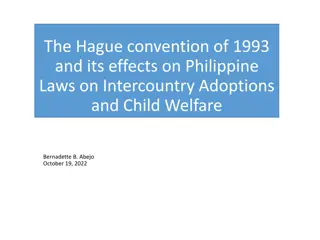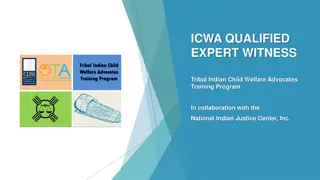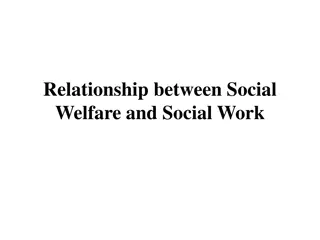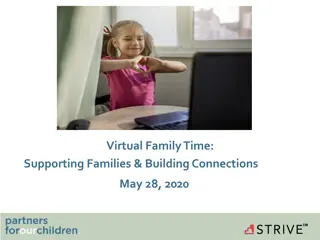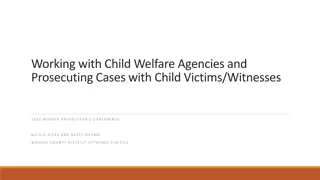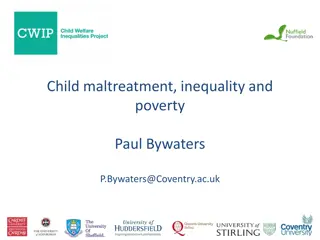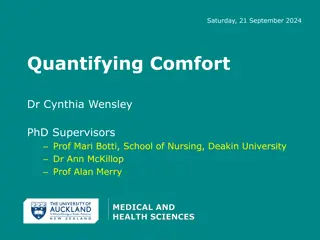Understanding Comfort Calls and Supporting Relationships in Child Welfare
Comfort calls are crucial telephone or video calls initiated by resource parents to a child's family within 24-48 hours of placement to strengthen relationships, reduce trauma, and facilitate communication of unique needs. Supporting relationships is legally required and involves engaging family members, building supportive teams, and addressing evolving needs in child welfare. These practices aim to reduce stress and regulate children's behavior by enhancing communication and collaboration among stakeholders.
Download Presentation

Please find below an Image/Link to download the presentation.
The content on the website is provided AS IS for your information and personal use only. It may not be sold, licensed, or shared on other websites without obtaining consent from the author. Download presentation by click this link. If you encounter any issues during the download, it is possible that the publisher has removed the file from their server.
E N D
Presentation Transcript
QPI Comfort Calls TRAINING FOR FOSTER FAMILY AGENCIES
Define what a comfort call is. Develop strategies that support implementation of Comfort Calls to parents whenever a child enters a new placement. Learning Objectives Understand policy guidelines that require Comfort Calls. Explore practice guidelines for comfort calls to support children.
What is a Comfort Call? A comfort call is telephone or video call initiated by the resource parents to the child s family 24-48 hours after a child is placed in their care. Comfort calls are designed to: Strengthen the relationship and communication between the child s family and the resource parents. Reduce trauma for children placed in out of home care. Allow the child s family to communicate unique needs and preferences of the child such as medical, behavioral, educational, developmental, social supports, routines, extracurricular activities, etc. Support shared parenting.
CPM guides service delivery and decision- making at all levels in Child Welfare QPI as part of California s Child Welfare Core Practice Model (CPM) CPM Practice Behaviors Identify and engage family members and others who are important to the child, youth, young adult, and family. Work with the family to build a supportive team. Facilitate the team process and engage the team in planning and decision-making with an in support of the child, youth, young adult, and family. Work with the team to address the evolving needs of the child, youth, young adult, and family. Work with the family to prepare for change in advance and provide tools for managing placement changes, social worker changes, and other significant transitions.
Supporting Relationships is Legally Required CA Welfare & Institutions Code 308 When child is taken into custody: CA Welfare & Institutions Code 16010.4 (b) It is in the children s best interests that their caregivers are privy to important information about them. (d) Caregivers should have certain basic information in order to provide for the needs of children placed in their care California Welfare & Institutions Code 16501(a)(4)(B)(i) The child and family team shall include representatives who provide formal supports to the child or youth and family when appropriate, including (I) The caregiver Social Workers must take steps to notify birth parents/guardians and relatives. Social Workers must provide the birth parent with a phone number to reach their child. Judge can order the disclosure of the resource parent s address Resource Parent can authorize the release of address anytime An initial phone call with the birth parent/guardian shall take place within 5 hours of the child being in custody CPS must ensure regular phone contact Agency must tell older children 10 years of age and older within 1 hour of custody that can call parent and an attorney
Reduce the divided loyalty stress. Helps regulate children s behavior by reducing anxiety. Comfort Calls Make a Difference for Children and their Families Ensures that families have all the information they need. Makes it easier for children to go home. Relieves the family s anxiety and enables them to resolve their issues. Makes children feel safer.
The comfort call is a phone or video call made by the resource parent to the family after a child is removed from their home. Comfort Call Protocol The purpose of these calls is to: Comfort the child. Take the first step in establishing a positive co-parenting relationship between the resource parents and the family. Discuss vital information needed to meet the child s needs. Diffuse anxiety of child and parent Allows the family to speak with the child after removal which may help them feel more comfortable with placement.
A comfort call takes place within 24-48 hours of the child being placed. Upon placement, the Social Services Practitioner (SSP) reminds the resource parent of the need to complete the comfort call and provides them with a CSD 4243 Comfort Calls brochure. The resource parents initiate the call. The family shares information with the resource parents that is pertinent to meet the child s needs while in placement. If new information is shared during the comfort call, the resource parent provides the information to the assigned SSP. If the SSP is not available, the resource parent is to leave a message to inform the SSP of the new information. Comfort Call Guidelines
Information Discussed during Comfort Call During the call, the resource parents allow the family to be the expert on their child by discussing information needed to meet the child s needs such as: Behavioral past trauma, placement history, therapeutic history, what are they afraid of, what comforts them, etc. Educational and Developmental school attended, teachers, academic performance, special services, etc. Medical allergies, medications, upcoming or needed appointments, immunizations, etc. Family/Fictive Kin/Peer support systems others can be in telephone communication to support the child Routines- extracurricular activities, schedules, bedtimes, etc. Hobbies, favorite foods, colors, toys books, etc.
General Guidelines The SSP discusses the upcoming comfort call with the family and resource parents and includes: The comfort call can be made in a variety of ways: From the resource parent s home phone or personal cell , if they feel comfortable with it. The best number to contact the family Timeframe to complete the call From an established Google Voice or Google Duo phone number using the resource parent s phone. Purpose of the call General expectations and guidelines If the family does not have access to a phone, the SSP or SSA may be able to facilitate the call.
Introduce themselves by first name or resource parents preferred way of being called. Explain they are calling to obtain information about the child that may only be known to the family to ensure they can provide the best care possible. Tell the family about themselves, to the extent they feel comfortable, and share how long they have been resource parents, who lives in their home, any activities or hobbies they have, and daily routines. Resource Parent Duties Acknowledge positive attributes, appearance, manners, etc. of the child. Discuss how the child is settling in. Acknowledge the difficulty of establishing this new relationship and highlight that the initial face to face meeting will be easier having had this conversation. Reiterate how beneficial it is to share important information and alleviate fears and anxiety through direct communication. If deemed appropriate by the SSP, allow the child to speak with their family. The conversation should be on speaker phone. If assistance is needed the SSP can help with setting guidelines. If the call becomes inappropriate, and the resource parent is unable to re- direct, the call should be terminated. Inform the family they will be in contact with them as soon as they know the details of the first/next visit. Determine best mode of communication by exchanging contact information for future communications.
After the call, the SSP contacts the resource parents and the family to ask if the comfort call took place. The SSP enters a contact note in CWS/CMS and includes the following information: SSP Duties after the Comfort Call Whether the call occurred Who participated in the call What was discussed Whether all parties were appropriate If call did not occur, the reason why it did not occur
Outcomes of Comfort Calls Provides for a smoother transition into the resource family home by allowing the resource parents to ask about specific information pertinent to their home environment and routines. Minimizes trauma of separation for both child and parents/guardians. Sets stage for an ongoing focus on the child. Reinforces that the family is the expert on their child. Reassures the family that the child will be well cared for and that the resource parent is committed to helping the family reunify. Provides the family the opportunity to convey, in their own words, the information they feel is critical for the care of their child. Establishes a positive working relationship early in the case by developing trust and open and honest communication. Initiates and promotes immediate communication between resource parents and the family humanizes stranger resource parents or sets the tone for a new relationship between the kinship resource parent and the family.
Unique Circumstances for Comfort Calls Hospitalized or Incarcerated Parents Parent s Whereabouts Unknown When a parent(s) are located, the initial call with the resource family should be done immediately to exchange information, reduce trauma for the child, and demonstrate trust and establishment of the relationship between caregivers. Special Circumstances When there are confirmed safety issues and risks that may preclude the initial call or require modification, the SSP will discuss with their supervisor the specific safety concerns, jointly assessing options and possible procedural modifications that would allow the call to occur safely. Depending on the hospital, treatment center, detention facility, etc. contact with an explanation of the purpose and procedures of the initial call with the physician, nurse, social worker, jail warden, etc. may allow for a brief or modified call. If the call cannot be conducted immediately due to hospitalization or incarceration, the call should be made as soon as possible once the parent is released or able to have access to the call.
Activity: Comfort Call Challenges and Solutions In small groups (break-out sessions) Develop a list of possible challenges to implementing comfort calls. Develop 1 or 2 solutions for each of the challenges listed. In large group, each group will share their responses.






